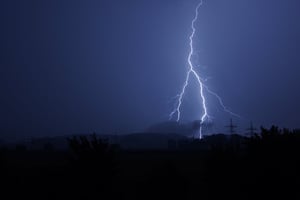A large concert stage collapsed under the pressure of 70mph winds at the Indiana State Fair a few years ago. Reports have indicated that at least five people have died and dozens more have been injured. According to a TIME Magazine article on the tragic events, AccuWeather had issued a warning of high wind gusts more than 15 minutes before the stage collapsed.
Fifteen minutes almost definitely would have been enough time to clear the concert area of the 12,000+ people waiting for the concert to begin. If organizers did, in fact, receive warnings from the National Weather Service or AccuWeather, they would have been forced to make a difficult decision. They could either clear the concert area and risk angering guests if a storm didn't actually materialize, or postpone an evacuation announcement and risk the safety of everyone in attendance if a storm did strike.
Forget the Wind, What About the Lightning?
Many people, including Indiana Governor Mitch Daniels, are saying that the extreme winds at the Indiana State Fair were an unpredictable "fluke". While this may be the case, several eyewitness reports indicate that lightning was visible for several minutes leading up to the large wind gusts. It is clear that a major storm system was rolling through. 
As we have previously discussed in our article on Lightning Strikes, if you can hear thunder, you should seek cover immediately because lightning can strike up to 25 miles away from a storm. With a tall, conductive structure like a concert stage, concert goers should have been evacuated long before the wind was even a factor.
It is crucial to know a detailed weather forecast any time your organization has outdoor activities planned. If there is any possibility for inclement weather (including extreme heat, heavy rain, tornadoes, thunderstorms, etc.) employees should know exactly how and where to direct guests to safety.
Disappointing People > Putting People at Risk
Christina Bossardet, a West Bend regional sales manager in Michigan, was visiting a county fair in the Western part of the state on the same day, and a similar storm rolled through. Just like organizers at the Indiana State Fair, officials at this fair failed to announce inclement weather was on its way. Here is Christina's eyewitness account:
The weather had been iffy all day. Two storms passed to the North, but it was clear that a third storm was coming fast. We could clearly see dark clouds and lightning in the distance, and we were getting texts from friends that there was heavy rain and strong winds heading straight for the fairgrounds.
I looked at the amusement ride operators and they were letting people on the rides, even though several lightning strikes were just witnessed. It appeared to be a pretty dangerous situation, so we exited the grounds and got to our vehicles as soon as possible.
The entire fairgrounds were in complete chaos; it didn't need to be that way. At no point did the fair announce any warning or where visitors could find shelter. We were lucky to get to our cars just in time.
It is unlikely that many of the readers of this blog plan or coordinate events at the scale of a county or state fair, but we know for a fact that the pressure of not disappointing members can be a daily struggle. A youth soccer camp may struggle with the idea of canceling a day of activities because of extreme heat, or lifeguards may find it difficult to clear a pool of paying customers when a thunderstorm is approaching. But as the saying goes...it's always better to be safe than sorry.
At the fairs in both Michigan and Indiana, it likely would have been an unpopular decision with guests to clear the fairgrounds as possible storms approached. After all, families paid good money for tickets and food. But sometimes, it is necessary to disappoint people in order to protect them.




